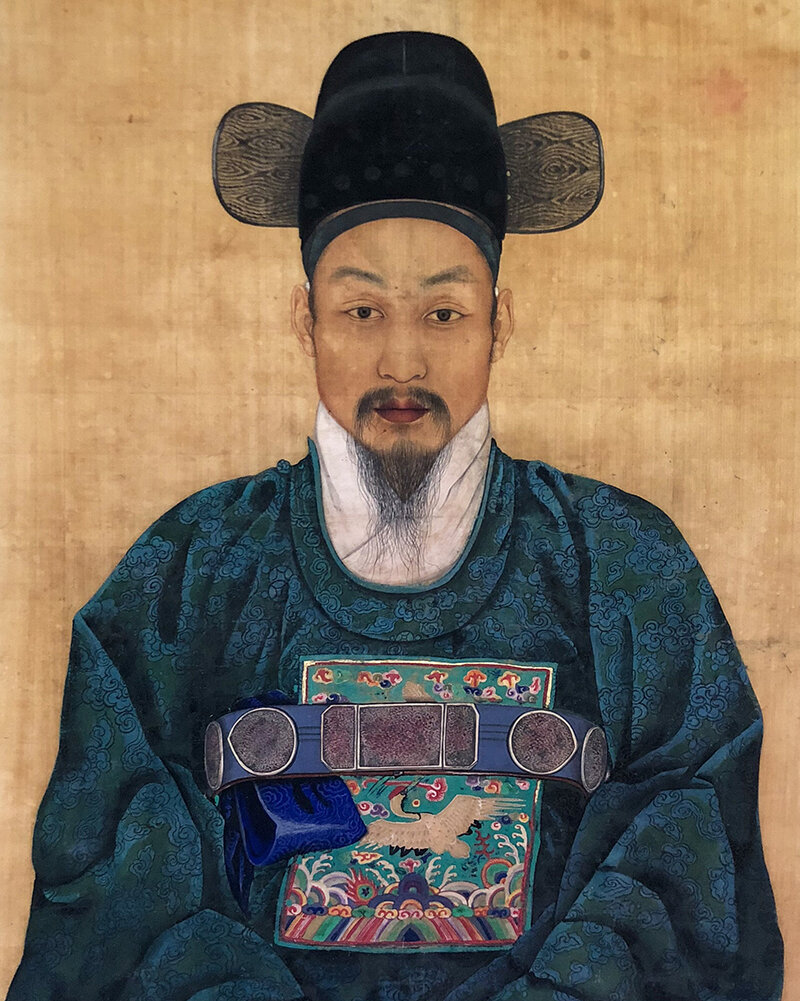Joseon Era Portrait
Ink and color on silk
Early 1900s
76 x 48 cm
The figure in this Joseon era portrait is wears the intricate green robe (단령, 團領) and accompanying hat (오사모, 烏紗帽) of an important official. His hands are lightly folded as he looks straight ahead, as if gazing directly at the viewer.
This direct, frontal facing view is a rare form of portraiture, and much fewer are known to be in existence, compared to the more common form of portait in which the subject is usually turned somewhat to the left, their profile partially exposed to view.
These type of frontal portraits first appeared occasionally beginning after the reign of King Sukjong, but began to be created more in earnest in the modern period, with the majority being painted by the royally-commissioned portrait artist Chae Yongshin (1850-1941).
The official robe is painted a rich, dark green with a delicate green-on-green pattern, achieved through the ombre dyeing technique (wherein a lighter pattern or gradient is created by first applying water to the painting surface). The robe features a colorful embroidered rank badge (흉배) with double crane design. While one crane is mostly covered by a blue belt (삽금대, 鈒金帶), the tip of its wing is still visible. The subject’s seated posture, with arms gently folded and hands clasped, cause the sleeves of the robe to hang gracefully in undulating folds, which the artist has carefully depicted through the use of light and shade.
The official hat has a relatively low profile at the rear, the main cap is rounded, and the two side wings are rather short and curved toward the front - all features which are particular to the late Joseon period. To further bring out the shape of the two side wings, curving forward toward the viewer, highlighting has been applied to their front edges for an added sense of depth.
The artist sketched the contours of the face in rust brown hues, and then focussed on the overall treatment of the face, modulating the amount of brush stroke and pigment to create shading and a sense of depth in three dimensions. This allowed for a heightened sense of realism. The lines of the eyelids were drawn in a darker shade, delicately bringing out the eyelashes. The pupils of the eyes are painted black, while the artist gave the iris an iridescent feel, using delicate gradation. The facial hair is depicted to a high level of detail. The depiction of the two eyebrows, for instance, is faithful to the original subject. Care was taken to paint each eyebrow differently, capturing the minute differences in shape and volume which are particular to the subject. This highly faithful realism is notable. The lips were first drawn in full using a purple hue, and then then a darker rust color was used to highlight the outer edges as well as inner edges where the lips meet, adding depth and shading.
The overall shading, realism, and techniques in this work are strikingly similar to those innovated and used by renowned royally-commissioned portrait artist Chae Yongsin (1850-1941) at the beginning of the modern period, suggesting that the work was painted during that period by the artist or one of his contemporaries in the Chaeseokgang School (채석강 도화소, 蔡石江圖畵所), which he operated.
